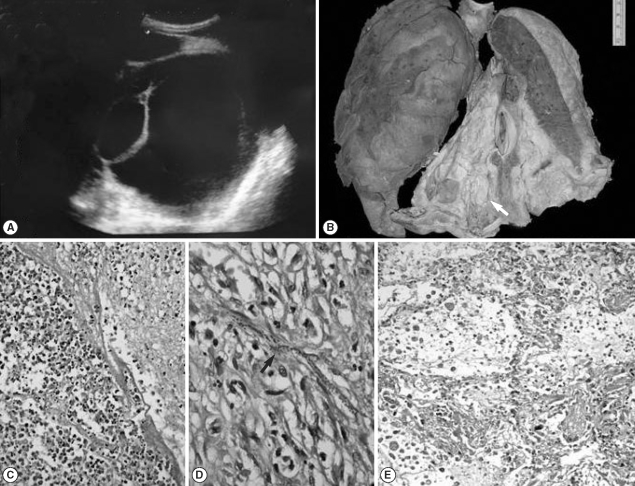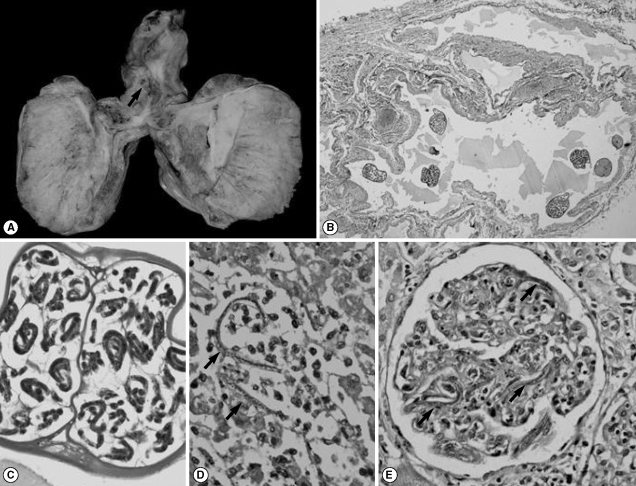Abstract
Clinical manifestations of extralymphatic disease caused by filariasis are varied and range from symptoms due to tropical pulmonary eosinophilia to hematuria, proteinuria, splenomegaly, and rarely arthritis. Disseminated microfilaremia in association with loculated lung cyst and empyema is of rare occurrence and to the best of our knowledge has not been documented in the literature so far. We report here a case of disseminated microfilaremia due to Wuchereria bancrofti infection accompanied by a lung cyst and empyema in a 21-year-old Indian man.
-
Key words: Wuchereria bancrofti, filariasis, microfilaria, extralymphatic manifestations
INTRODUCTION
Extralymphatic filarial disease is heterogeneous in its pathogenesis and clinical manifestations. Unlike lymphatic disease syndromes, the extralymphatic manifestations of bancroftian filariasis are not caused by the adult worm per se, but by microfilariae, by diffusible products from yet undefined parasite stages, or by immune complexes [
1]. We have encountered an autopsy case of disseminated microfilaremia due to bancroftian filariasis accompanied by a lung cyst and empyema in a young Indian man.
CLINICAL SUMMARY
A 21-year-old male presented with progressive breathlessness for the past 2 months with pain in the right upper quadrant of the abdomen for 4 days duration. He also complained of cough with scanty expectoration and high grade fever of similar duration. There was no history of pedal edema, decreased urine output, abdominal distention, chest pain, or palpitation. On examination, he had tachycardia with raised blood pressure (160/90 mm of Hg), but the other vitals were stable. The jugular venous pressure (JVP) was normal. There was tenderness in the right upper quadrant with hepatomegaly. The spleen was not palpable and no ascitis was noted. Cardiovascular system examination revealed a loud S2 with a pansystolic murmur in the tricuspid area. Chest examination revealed bilateral crepitations. Investigations revealed leucocytosis (TLC-16,800) with mild eosinophilia (16%). Renal function tests were deranged with raised blood urea (75 mg/dl) and serum creatinine (1 mg/dl). Chest X-ray showed an opaque left hemithorax, and on ultrasonography a large, well defined, anechoic cystic lesion was seen occupying the entire left hemithorax with multiple septations (
Fig. 1A), suggesting the possibility of a hydatid cyst. The liver span was 12 cm with normal echotexture. Microscopic examinations of the pleural fluid revealed 2,800 pus cells with 2 mg/dl sugar and 6 g/dl proteins. The patient was treated with injection of Lasix and antibiotics; however, his condition soon deteriorated and he succumbed to his illness with cardiorespiratory arrest.
AUTOPSY FINDINGS
A partial autopsy was performed following an informed consent. Mild bilateral scrotal sac enlargement was noted. There was bilateral pleural effusion with 1,500 ml of straw colored fluid and bilateral hydrocoele with 20 ml of fluid in the scrotal sac. Both lungs weighed 730 g, and there was marked pleuritis with fibrinous tags (left > right). A large multi-loculated pleural based cyst (10 × 8 × 3 cm) filled with thick greenish material was present on the left side (
Fig. 1B). Multiple tiny nodular lesions (4-5 mm) were palpable in the rest of the lung parenchyma. Microscopically, the cyst was confirmed to be a loculated empyema with outer fibrous wall, scattered giant cells, and the lumen filled with fibrin-rich acute inflammatory exudate chiefly comprising of eosinophils (
Fig. 1C). Also seen in the cavity wall were many sheathed microfilariae of
Wuchereria bancrofti (with absence of characteristic fine nuclei in the tail) (
Fig. 1D). Other areas revealed features of tropical pulmonary eosinophilia (TPE) with eosinophilic alveolitis and bronchitis (
Fig. 1E). A large thrombus was noted in the main pulmonary artery with large areas of infarction, and adjacent areas showed presence of heart failure cells within the alveoli.
The size and weight of both testes was normal. The spermatic cords were firm in consistency with presence of tiny, whitish nodules (1-2 mm) along its length (
Fig. 2A). Microscopically, multiple calcified and hyalinized granulomas were noted around a dead filarial worm with eosinophil rich inflammatory infiltrates. A live adult gravid female worm was also noted within dilated lymphatic vessels (
Fig. 2C). The rest of the testicular parenchyma was normal. The liver was enlarged, firm in consistency, and weighed 1,100 g. On microscopy there was evidence of centrizonal sinusoidal dilatation and focal hepatocytic necrosis with presence of microfilariae within the centre of these necrotic foci (
Fig. 2D). The spleen weighed 110 g, and on microscopy it showed presence of ill-formed granulomas and eosinophilic microabscesses around microfilariae. The kidneys weighed 280 g and were normal in size. Many glomerular capillaries showed presence of fibrin thrombi along with many microfilariae (
Fig. 2E). Few glomeruli also revealed necrotizing lesions. The interstitium showed eosinophilic microabscesses with microfilariae. The heart weighed 250 g, and there were features of chronic rheumatic valvulitis with thickened, stenotic mitral valve leaflets, chordate, and commissural fusion. Also tiny verrucous vegetations (1-2 mm) were noted on the atrial aspect of the mitral valve along the line of closure of the leaflet. On microscopic examination, the vegetations were confirmed to be non-bacterial in origin. Features of eosinophilic hypersensitive myocarditis with patchy endomyocardial fibrosis (EMF), secondary to hypereosinophilia, were noted in the ventricular myocardium.
DISCUSSION
W. bancrofti is a nematode causing lymphatic filariasis throughout tropics and subtropics [
2]. The adult worm inhabits the lymphatics and produces lymphangitis and lymphadenitis, and the female produces sheathed microfilariae which circulate in the peripheral blood. Besides, the well documented lymphatic manifestations, the larval forms of
W. bancrofti,
Brugia malayi, and
Brugia timori are also associated with extralymphatic pathology and disease. Reports of extralymphatic manifestations producing end organ damage due to microfilariae of
W. bancrofti have been documented in the literature [
1,
3].
TPE is the best known clinical manifestation of occult filariasis [
4]. This is supported by the fact that filarial complement fixation test is sometimes positive and often there is a dramatic clinical response to the administration of antifilarial drugs [
5]. The condition is often thought to represent an immunopathological response to the presence of parasite and immune hypersensitivity to microfilariae, rather than direct damage by it, and is believed to be the basic underlying pathogenetic mechanism.
Microfilariae are trapped and destroyed in the lung by antibody-dependent, cell-mediated cytotoxicity involving eosinophils, and these degenerating worms release somatic allergens that bind specific cell-bound IgE and thereby trigger the release of vasoactive and inflammatory molecules by lung basophils and mast cells [
6]. Microfilariae and degenerated worm fragments are present in lung nodules of patients with TPE, thus providing support to this pathogenetic mechanism [
7]. Microfilariae were detected within the fibrous wall of the lung cyst in the index case with eosinophils and fibrin-rich inflammatory exudate surrounding it. However, their presence seems to be incidental and not a causative mechanism for cyst formation and empyema.
Besides TPE in the lungs, destruction of microfilariae in other organs is also known to produce tissue damage by a similar pathogenetic mechanism, and finding of microfilariae or dead worm (s) with surrounding eosinophil rich inflammatory response supports this hypothesis. In the present case, besides TPE, there was extensive tissue damage in the heart, kidneys, liver and spleen with presence of microfilariae in each of these organs. The extensive inflammatory responses due to microfilariae and the infection of the lung cyst may have resulted in toxemia which together with pulmonary thromboembolism led to the demise of the patient.
The association between eosinophilia and EMF with eosinophilic hypersensitive myocarditis has been well documented in the literature [
8,
9]. The myocardium in the present case revealed features of eosinophilic hypersensitive myocarditis with EMF. The major basic protein released from eosinophils has been implicated to play a major role in producing the tissue damage. Similarly, necrotizing lesions were seen within the glomeruli along with presence of fibrin thrombi. There were eosinophilic abscesses within the interstitium, and microfilariae were noted both within the glomerular capillaries and in the abscesses. Although the patient did not have any renal symptoms, microscopic hematuria and proteinuria have been documented in 45% of untreated microfilaremic patients [
1]. Both deposition of immune complexes in the glomerular basement membrane and mechanical damage to glomeruli by circulating microfilariae are believed to account for the hematuria in these cases [
10].
In the liver and spleen also, organ damages were produced by products of microfilarial worms. The liver revealed sinusoidal dilatation and focal hepatocytic necrosis with presence of microfilariae within the necrotic foci. In the spleen, there were ill formed granulomas, and eosinophilic microabscess around microfilariae.
In conclusion, the present case, besides highlighting the extralymphatic manifestations and multi-organ damage produced by microfilariae of W. bancrofti, also illustrates the rare occurrence of disseminated microfilaremia associated with lung cyst and loculated empyema. Documentation of such cases would further help in understanding the pathogenetic mechanisms that underlie the extralymphatic organ damages seen in occult filariasis.
References
Fig. 1(A) An oblique sonogram of the chest revealing a large multi-septate cystic collection in the left pleural cavity. (B) The left lung showing a large multi-loculated pleural based cyst. (C) Acute inflammatory infiltrates rich in eosinophils in the lumen and wall of the cyst (H-E, ×100). (D) Microfilariae of Wuchereria bancrofti present in the cystic wall (H-E, ×200). (E) Eosinophil rich inflammatory infiltrates along with fibrin filling the alveoli and the alveolar septae (H-E, ×100).

Fig. 2(A) Two testes with tiny, whitish nodules (1-2 mm) (arrow) along the length of the spermatic cord. (B) A live adult gravid female worm within the dilated lymphatic vessels (H-E, ×40). (C) Many sheathed microfilariae present within the gravid female worm (H-E, ×200). (D) Microfilariae present in the centre of necrotic foci within the hepatocytic lobule (H-E, ×200). (E) Microfilariae entrapped within the glomerular capillaries (H-E, ×200).

Citations
Citations to this article as recorded by

- Immunopathological response of leukocytes against microfilariae and adult worms in white rats infected with Setaria cervi
Sharba Kausar, Wajihullah Khan
Veterinary World.2017; 10(5): 562. CrossRef - Sudden Death Due to Coronary Blockade by Microfilaremia
Rajpal Singh Punia, Reetu Kundu, Dasari Harish
American Journal of Forensic Medicine & Pathology.2016; 37(4): 231. CrossRef






